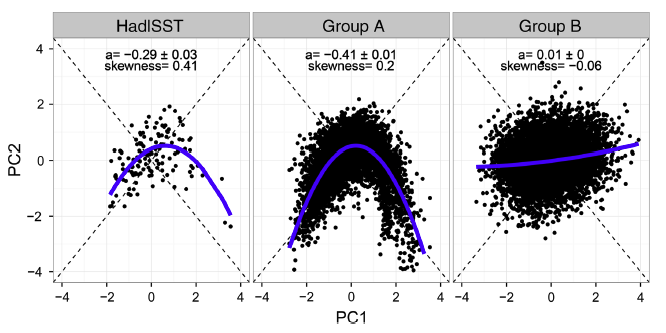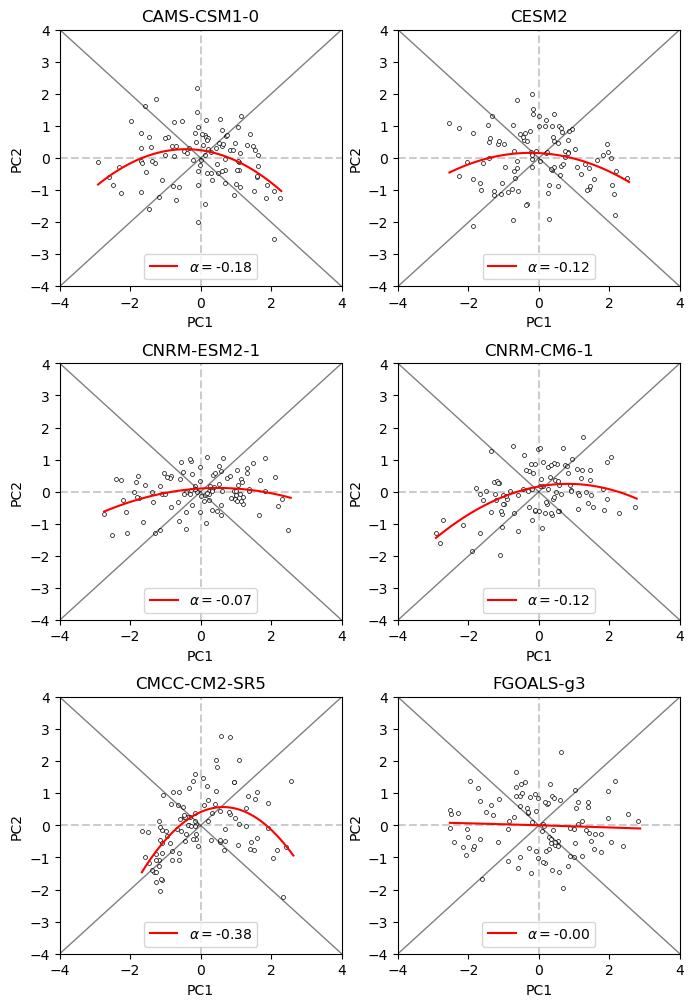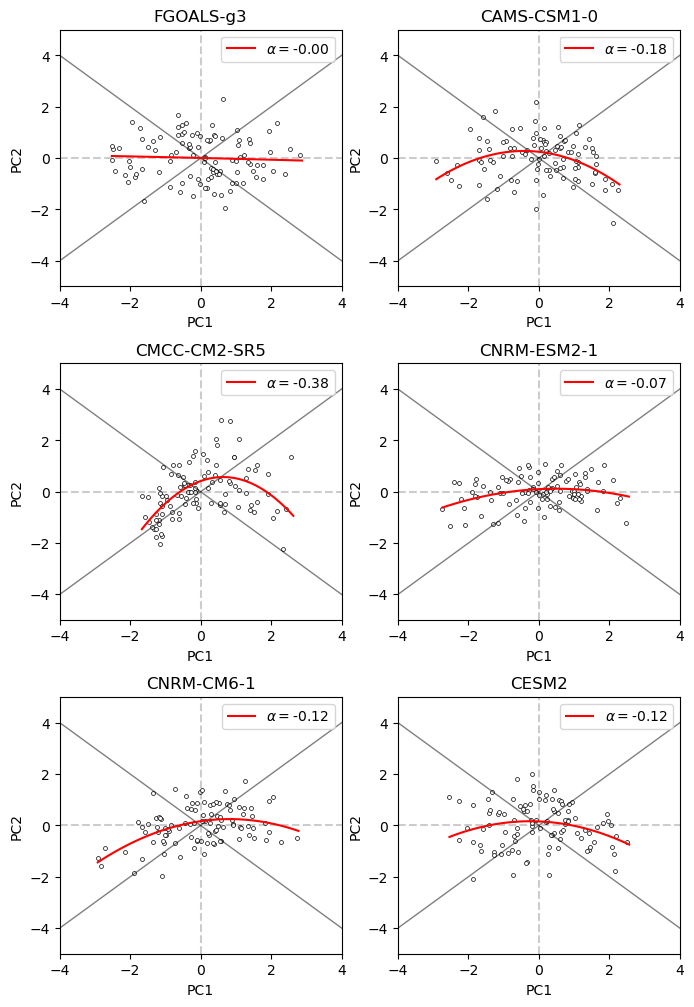Compute Demo: ENSO nonlinearity index with CMIP6 data
Overview
In this demo we combine multiple multiple tools described in previous cookbooks to subset, regrid and process CMIP6 data. We will be computing a measure of ENSO nonlinearity by computing the EOFs of the pacific sea surface temperature anomalies. This measure is particularly useful for characterizing models by their ability to represent different ENSO extremes (Karamperidou et al., 2017).
The process we are going to follow in this demo is:
Find the CMIP6 data we need using intake-esgf
Subset the data and regrid it to a common grid using Rooki
Load the datasets into xarray and perform the computations
Plot the results
Prerequisites
Concepts |
Importance |
Notes |
|---|---|---|
Necessary |
How to use xarray to work with NetCDF data |
|
Necessary |
How to configure a search and use output |
|
Helpful |
How to initialize and run rooki |
|
Helpful |
Understanding of EOFs |
Time to learn: 20 minutes
Imports
import os
import intake_esgf
# Run this on the DKRZ node in Germany, using the ESGF1 index node at LLNL
os.environ["ROOK_URL"] = "http://rook.dkrz.de/wps"
intake_esgf.conf.set(indices={"anl-dev": False,
"ornl-dev": False,
"esgf-node.llnl.gov": True})
import matplotlib.pyplot as plt
import numpy as np
import numpy.polynomial.polynomial as poly
import xarray as xr
import xeofs as xe
from intake_esgf import ESGFCatalog
from rooki import operators as ops
from rooki import rooki
Retrieve subset of CMIP6 data
The CMIP6 dataset is identified by a dataset-id. Using intake-esgf we can query the ESGF database for the variables and models we are interested in. For this demo we are interested in the tos (sea surface temperature) variable for the historical runs. Also, for sake of simplicity we will only query a subset of the models available.
cat = ESGFCatalog()
cat.search(
experiment_id=["historical"],
variable_id=["tos"],
table_id=["Omon"],
project=["CMIP6"],
grid_label=["gn"],
source_id=[
"CAMS-CSM1-0",
"FGOALS-g3",
"CMCC-CM2-SR5",
"CNRM-CM6-1",
"CNRM-ESM2-1",
"CESM2",
],
)
cat.remove_ensembles()
print(cat)
Summary information for 6 results:
mip_era [CMIP6]
activity_drs [CMIP]
institution_id [CAMS, NCAR, CNRM-CERFACS, CMCC, CAS]
source_id [CAMS-CSM1-0, CESM2, CNRM-ESM2-1, CNRM-CM6-1, ...
experiment_id [historical]
member_id [r1i1p1f1, r1i1p1f2]
table_id [Omon]
variable_id [tos]
grid_label [gn]
dtype: object
Once the catalog has been queried, we have to do some manipulation in pandas to keep only the dataset_id. This has to be done because the same data has multiple locations online, and these get appended at the end of the dataset_id. Rookie only accepts the dataset_id without the online location, so we get rid of it in the next step.
def keep_ds_id(ds):
return ds[0].split("|")[0]
collections = cat.df.id.apply(keep_ds_id).to_list()
collections
['CMIP6.CMIP.CAMS.CAMS-CSM1-0.historical.r1i1p1f1.Omon.tos.gn.v20190708',
'CMIP6.CMIP.NCAR.CESM2.historical.r1i1p1f1.Omon.tos.gn.v20190308',
'CMIP6.CMIP.CNRM-CERFACS.CNRM-ESM2-1.historical.r1i1p1f2.Omon.tos.gn.v20181206',
'CMIP6.CMIP.CNRM-CERFACS.CNRM-CM6-1.historical.r1i1p1f2.Omon.tos.gn.v20180917',
'CMIP6.CMIP.CMCC.CMCC-CM2-SR5.historical.r1i1p1f1.Omon.tos.gn.v20200616',
'CMIP6.CMIP.CAS.FGOALS-g3.historical.r1i1p1f1.Omon.tos.gn.v20191107']
We are left with a list of dataset_ids that Rookie can accept as input for the next step.
Subset and regrid the data
We define a function that will do the subset and regridding for us for each of the dataset_ids we have. The function will take the dataset_id as input and then use Rookie functions to select 100 years of data for the tos variable in the Pacific Ocean region. We don’t need high resolution data for this particular use, so 2.5 degree resolution is enough.
def get_pacific_ocean(dataset_id):
wf = ops.Regrid(
ops.Subset(
ops.Input("tos", [dataset_id]),
time="1900-01-01/2000-01-31",
area="100,-20,280,20",
),
method="nearest_s2d",
grid="2pt5deg",
)
resp = wf.orchestrate()
if resp.ok:
print(f"{resp.size_in_mb=}")
ds = resp.datasets()[0]
else:
ds = xr.Dataset()
return ds
sst_data = {dset: get_pacific_ocean(dset) for dset in collections}
resp.size_in_mb=47.61836910247803
Downloading to /tmp/metalink_m022y6_i/tos_Omon_CAMS-CSM1-0_historical_r1i1p1f1_gr_19000116-20000116_regrid-nearest_s2d-72x144_cells_grid.nc.
resp.size_in_mb=47.61574363708496
Downloading to /tmp/metalink_gdanik73/tos_Omon_CESM2_historical_r1i1p1f1_gr_19000115-20000115_regrid-nearest_s2d-72x144_cells_grid.nc.
resp.size_in_mb=47.6201171875
Downloading to /tmp/metalink_cfolrf2h/tos_Omon_CNRM-ESM2-1_historical_r1i1p1f2_gr_19000116-20000116_regrid-nearest_s2d-72x144_cells_grid.nc.
resp.size_in_mb=47.621718406677246
Downloading to /tmp/metalink_5upqmp7u/tos_Omon_CNRM-CM6-1_historical_r1i1p1f2_gr_19000116-20000116_regrid-nearest_s2d-72x144_cells_grid.nc.
resp.size_in_mb=47.622283935546875
Downloading to /tmp/metalink_kt9_flu6/tos_Omon_CMCC-CM2-SR5_historical_r1i1p1f1_gr_19000116-20000116_regrid-nearest_s2d-72x144_cells_grid.nc.
resp.size_in_mb=47.61813259124756
Downloading to /tmp/metalink_qj2_0i2t/tos_Omon_FGOALS-g3_historical_r1i1p1f1_gr_19000116-20000116_regrid-nearest_s2d-72x144_cells_grid.nc.
ENSO nonlinearity measure: alpha value
This part of the demo is computation heavy. You can refer to Takahashi et al. (2011) and Karamperidou et al. (2017) for more details on the usefulness and computation of the alpha parameter.
The alpha parameter is computed by doing a quadratic fit to the first two EOFs for the DJF season of the SST anomalies in the Pacific region. We are looking to obtain two EOFs modes that represent the Eastern and central pacific SST patterns, which is why we include a correction factor to account for the fact the sometimes the EOFs come with the opposite sign.
The higher the value of alpha, the more nonlinear (or extreme) ENSO events can be represented by the model. Likewise, a model with lower alpha values will have a harder time representing extreme ENSO events, making it not suitable for climate studies of ENSO in a warming climate (Cai et al., 2018, 2021).
We are looking to obtain data that can reproduce a figure similar to the one below (taken from Karamperiou et al., 2017):

Each of the “wings” of this boomerang-shaped distribution represents a different ENSO extreme, with the left (right) wing representing the extreme central (eastern) pacific El Niño events. More details on Takahashi et al. (2011).
def compute_alpha(pc1, pc2):
coefs = poly.polyfit(pc1, pc2, deg=2)
xfit = np.arange(pc1.min(), pc1.max() + 0.1, 0.1)
fit = poly.polyval(xfit, coefs)
return coefs[-1], xfit, fit
def correction_factor(model):
_eofs = model.components()
_subset = dict(lat=slice(-5, 5), lon=slice(140, 180))
corr_factor = np.zeros(2)
corr_factor[0] = 1 if _eofs.sel(mode=1, **_subset).mean() > 0 else -1
corr_factor[1] = 1 if _eofs.sel(mode=2, **_subset).mean() > 0 else -1
return xr.DataArray(corr_factor, coords=[("mode", [1, 2])])
def compute_index(ds):
tos = ds.tos.sel(lat=slice(-20, 20), lon=slice(100, 280))
tos_anom = tos.groupby("time.month").apply(lambda x: x - x.mean("time"))
# Compute Eofs
model = xe.models.EOF(n_modes=2, use_coslat=True)
model.fit(tos_anom, dim="time")
corr_factor = correction_factor(model)
# eofs = s_model.components()
scale_factor = model.singular_values() / np.sqrt(model.explained_variance())
pcs = (
model.scores().convert_calendar("standard", align_on="date")
* scale_factor
* corr_factor
)
pc1 = pcs.sel(mode=1)
pc1 = pc1.sel(time=pc1.time.dt.month.isin([12, 1, 2]))
pc1 = pc1.resample(time="QS-DEC").mean().dropna("time")
pc2 = pcs.sel(mode=2)
pc2 = pc2.sel(time=pc2.time.dt.month.isin([12, 1, 2]))
pc2 = pc2.resample(time="QS-DEC").mean().dropna("time")
alpha, xfit, fit = compute_alpha(pc1, pc2)
return pc1, pc2, alpha, xfit, fit
Now we can compute the alpha parameter for each of the models we have selected.
alpha_fits = {}
for key, item in sst_data.items():
if len(item.variables) == 0:
continue
alpha_fits[key] = compute_index(item)
Plot the results
Finally, we can plot the results of the alpha parameter for each of the models we have selected. This will give us an idea of how well the models represent different ENSO extremes.
fig, axs = plt.subplots(nrows=3, ncols=2, figsize=(8, 12))
axs = axs.ravel()
for num, (ds, (pc1, pc2, alpha, xfit, fit)) in enumerate(alpha_fits.items()):
ax = axs[num]
ax.axhline(0, color="k", linestyle="--", alpha=0.2)
ax.axvline(0, color="k", linestyle="--", alpha=0.2)
# draw a line 45 degrees
x = np.linspace(-6, 6, 100)
y = x
ax.plot(x, y, color="k", alpha=0.5, lw=1)
ax.plot(-x, y, color="k", alpha=0.5, lw=1)
ax.scatter(
pc1,
pc2,
s=8,
marker="o",
c="w",
edgecolors="k",
linewidths=0.5,
)
ax.plot(xfit, fit, c="r", label=f"$\\alpha=${alpha:.2f}")
ax.set_xlabel("PC1")
ax.set_ylabel("PC2")
ax.set_title(ds.split(".")[3])
ax.set_xlim(-4, 4)
ax.set_ylim(-4, 4)
ax.legend()
fig.subplots_adjust(hspace=0.3)

From this example, we can see that from the subset of models we have selected, the alpha parameter is higher for CMCC-CM2-SR5 compared to the other models as the “boomerang” shape is better represented in this model. This indicates that this model is better at representing extreme ENSO events compared to the other models.
Summary
In this notebook, we used intake-esgf with Rooki Python client to retrieve a subset of a CMIP6 dataset. The subset and regrid operations are executed remotely on a Rook subsetting service (using OGC API and xarray/clisops). The dataset is analyzed using xeofs to extract a measurement used in ENSO research. We also showed that remote operators can be chained to be executed in a single workflow operation.
References
Cai, W., Santoso, A., Collins, M., Dewitte, B., Karamperidou, C., Kug, J.-S., Lengaigne, M., McPhaden, M. J., Stuecker, M. F., Taschetto, A. S., Timmermann, A., Wu, L., Yeh, S.-W., Wang, G., Ng, B., Jia, F., Yang, Y., Ying, J., Zheng, X.-T., … Zhong, W. (2021). Changing El Niño–Southern Oscillation in a warming climate. Nature Reviews Earth & Environment, 2(9), 628–644. https://doi.org/10.1038/s43017-021-00199-z
Cai, W., Wang, G., Dewitte, B., Wu, L., Santoso, A., Takahashi, K., Yang, Y., Carréric, A., & McPhaden, M. J. (2018). Increased variability of eastern Pacific El Niño under greenhouse warming. Nature, 564(7735), 201–206. https://doi.org/10.1038/s41586-018-0776-9
Karamperidou, C., Jin, F.-F., & Conroy, J. L. (2017). The importance of ENSO nonlinearities in tropical pacific response to external forcing. Climate Dynamics, 49(7), 2695–2704. https://doi.org/10.1007/s00382-016-3475-y
Takahashi, K., Montecinos, A., Goubanova, K., & Dewitte, B. (2011). ENSO regimes: Reinterpreting the canonical and Modoki El Niño. Geophysical Research Letters, 38(10). https://doi.org/10.1029/2011GL047364
